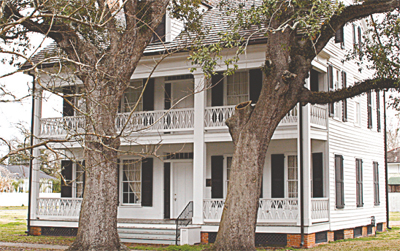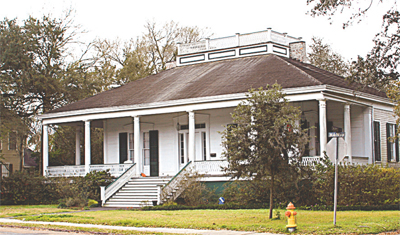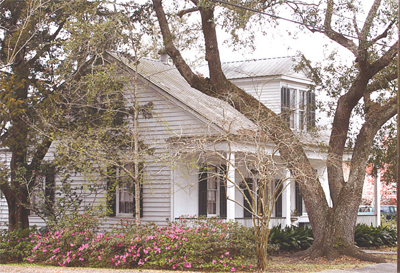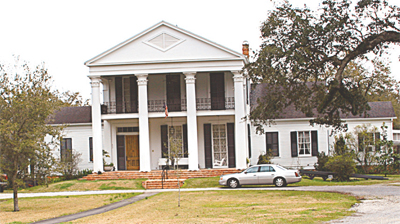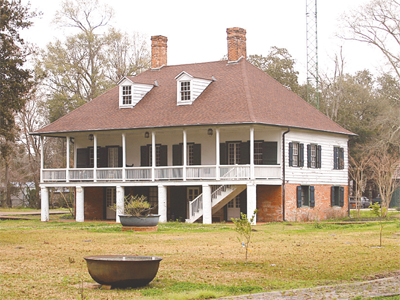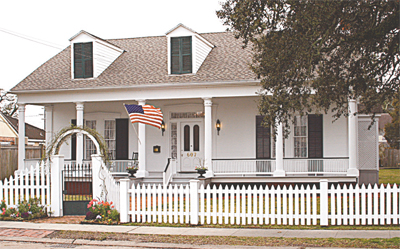Walking Tours
| Franklin, Louisiana is rich in history and unique Anglican antebellum houses that are all within walking distance of each other.
Founded in 1808 as Carlin's Settlement and named for Benjamin Franklin, Franklin became the parish seat in 1811 and the first incorporated town in 1820. Though early settlers included French, Acadian, German, Danish and Irish, the town's culture and architecture is heavily influenced by the unusually large numbers of English that chose to settle there after the Louisiana Purchase in 1803. Numerous large sugar plantations arose in the area, and with the development of steamboating, Franklin became an interior sugar port. By the 1830s, Bayou Teche was the main street of Acadiana, with one plantation after another.
|
|
| Foster - O'Neill House 201 Main: Built prior to 1852, the house was the residence of Thomas J. Foster, father of Governor M.J. Foster. The sloping room has two gable end dormers with two corbelled chimneys at either end of the house. The front gallery is faced with cypress flush board of a narrow width. |
|
| Trowbridge House 808 First Street: Built in 1827 by Issac Trowbridge, a native of Connecticut, it is the oldest two-story building in the area. The home was made of cypress using wooden-peg construction. The house remained in the Trowbridge family for more than a century and a half. It was restored in the 1990s and donated to St. Mary's Episcopal Church. |
|
| Mentz-Fleming House 203 Main: Built circa 1890 by Phillip H. Mentz. The house has gable end construction with a hipped transverse section extending out to a bay below it on one side. There is a quatre-foil design in the center in the pediment just above the second floor gallery. |
|
| Alfred Gates 205 Main: Built by Alfred Gates. The house has a hipped roof with a widow's walk at the top that shows an open balustrade of lozenge design above a paneled section. A wide stairway leads to the front gallery which extends across the width and partial sides of the house. |
|
| Schwartz House 813 First Street: Constructed between 1830 and 1832, this cottage was occupied by the school of Miss Carolyn Burroughs for a period. It was the home of the Joseph Schwartz family from 1909 to 1993. In 1994, it was restored as a rental property. |
|
| Bittersweet 301 Main: Built in early to middle 1800's. Bittersweet has window and door surrounds of neo-classic design with a multi-paned lunette over the original front door. Louvered shutters remain on all windows and doors. |
|
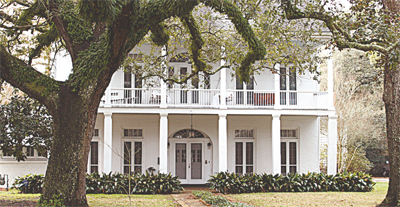 Click image for larger view |
Allain House 909 Second St.: Built in 1832 as a dwelling, it housed the first bank outside New Orleans in South Louisiana. It was occupied by Union forces during the Civil War, and according to legend, Davy Crockett stayed there as he traveled to Texas and the Battle of the Alamo. |
| Three Oaks 305 Main: Built on the site of the present post office by the Hine family in the 1850's. The house was moved to its present location in 1910 with the four beautiful free standing Corinthian columns being moved intact. An elegant recessed front door has a double elliptical arch supported by pilasters which match the main columns. |
|
| Frere-O'Neill House 307 Main: Late Victorian two-story residence, owned at one time by the late Charles Austin O'Neill, Chief Justice of the Supreme Court. The imbricate fish scale shingles, which are prominent on the front of the upper story, are an interesting detail. |
|
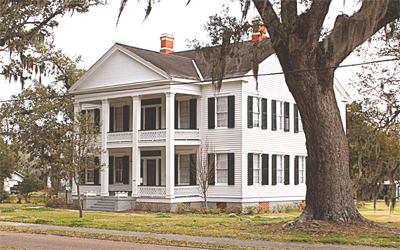 Click image for larger view |
Smardon-Hanson House 114 Main: Built around 1849 by Thomas Smardon, an Englishman. Well-framed formal doorways open onto the portico at both levels having top and side lunettes with leaded glass panels and leaded glass door at the center. The upstairs balustrade has a fleur-de-lis motif. |
| Palfrey House 200 Main: Built circa 1851 by Governor Joshua Baker for his daughter Frances Baker Palfrey. On the site of a former grits mill and sugar plantation, the house has a neo-classic doorway framed with multi-paneled lunettes. The four wooded Corinthian columns, which are across the front of the house, are repeated on the rear porch facing Bayou Teche. |
|
| Cypress House 300 Main: Built at the turn of the century by Wilson McKerall, one time Mayor of Franklin. Outstanding features are the pyramidal roof, beveled and leaded door and side lunettes, and Corinthian columns supporting a one-story gallery with a parapet above. |
|
| Darby House 606 Main St., Baldwin: One of the few French Colonial homes in the area and probably the oldest extant building in St. Mary Parish. The home was built by Alfred Hennen near the end of the eighteenth century. It is named for Francois Darby, its 1856 purchaser. |
|
| Magnolia House 302 Main: Built in 1966 by Mr. and Mrs. Clarnece W. Baughman. Patterned after Landsdowne in Natchez, Mississippi, it is of brick of the cottage type with wide steps curved upward to a gallery bordered by fluted columns and iron grid work. |
|
| Oliver-Todd House 607 Second St.: Built for Jules Oliver in 1854, the home was later divided into apartments. During the 1930s it fell into disrepair, but it was saved in the 1980s by a new owner who completely restored the home. |
|
| Sterling Gates House 304 Main: Built circa 1904 by Dr. Sterling Gates. An interesting feature is the Cross and Bible solid wooden paneled door. Small cypress columnettes, brackets and elliptical arches are accented by scalloped design on the front gallery. |
|
| Saint House 303 Main: Built by Judge and Mrs. Percy Saint in 1908. Judge Saint later became the Attorney General for the State of Louisiana. Styled in the manner of the Woodcraft movement, the house has columns which are shingled with overlapping weatherboard. The front gable pediment has a wattle and daub treatment. |
|
